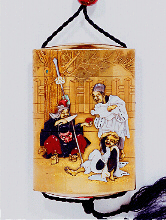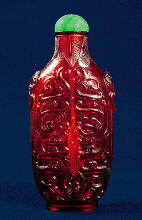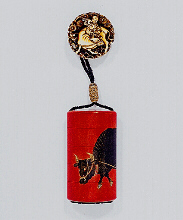|
 Shibayama style inro Signed: Tokusai
 Imperial ruby-red Chinese snuff bottle
|
||
| To return to the Articles index | To the next 3 pictures | |
|
Manju: Ivory openwork manju carved with a boy playing the flute whilst sitting on an ox. The reverse similarly carved with Chinnan and a dragon. Japan, 19th century. Unsigned. See more information on this ox & boy manju (N35) in the Japanese Netsuke section. Ojime: Gilt metal with raised floral design. A red four case togidashi Inro. Decorated on the red ground, lightly powdered in gold, with a boy playing the flute whilst sitting beside an ox. Signed: Shiomi Masanari. Provenance: Eskenazi. Published: Item 321(inro) 'In Search of Netsuke and Inro' by George A. Cohen. Dimensions: 9.2cm long x 5cm wide. The Shiomi family of lacquerers, most of whom used the name Masanari, started working in the late 17th century and continued through to the first few years of the 20th century. The Present example is undoubtedly by one of the later members of the family.
A four case gold Inro richly decorated, in Shibayama style with actors in a play. Signed: On a red seal Tokusai. Provenance: D. Wright. Published: Front cover and item 354 'In Search of Netsuke and Inro' by George A. Cohen. Dimensions: 9.7cm long x 6.8cm wide.
Glass, translucent ruby-red exquisitely carved with writhing and confronting archaic dragons, the neck surrounded with palm fronds, the shoulders carved with mask ring handles; the bottle of elegant, tall flattened form with a raised oval foot rim. Chinese, Qianlong period, 1736-1795. Stopper: Green jadeite. Provenance: Hugh Moss Ltd, London, 1975. Height: 8.5cm. The design, manufacture, essence and inspiration for this beautiful glass work of art are pure Imperial: even the form itself without the decoration would imply the bottle was made at the glass works in the Forbidden City, Beijing.
|
||
|
One Time Payment of 25 Euros For Unlimited Access to The Cohen Collection
|
||
